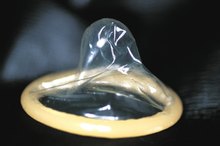A Smelly Vaginal Discharge During Pregnancy
Increased vaginal discharge is a common complaint during pregnancy, and is the result of fluctuating hormones and increased blood circulation in the vaginal area. Heavier discharge can occur throughout pregnancy without concern. A pregnant woman should seek medical attention, however, if vaginal discharge becomes smelly, changes from clear or white to green or yellow, or if the vaginal area becomes itchy or irritated. These are signs of a possible vaginal infection and require treatment.
Types
There are two types of vaginal infections with symptoms that include a smelly discharge—bacterial vaginosis, or BV, and a yeast infection. BV occurs when normal bacteria in the vagina grows out of balance. According to the Centers for Disease Control and Prevention, BV is the most common vaginal infection in women of childbearing age, whose symptoms include heavy discharge that can change in color, a strong and almost fish-like odor, pain, and itching or burning during urination.
Similar to BV, yeast infections are also common during pregnancy. They are caused by an overgrowth of the candida albicans bacteria, and doctors often use the term “candidiasis” when discussing yeast infections. Pregnant women are particularly susceptible to yeast infections, according to American Pregnancy.org. Symptoms include yellowish discharge with a yeast or bread-like smell, itching and irritation.
- There are two types of vaginal infections with symptoms that include a smelly discharge—bacterial vaginosis, or BV, and a yeast infection.
- According to the Centers for Disease Control and Prevention, BV is the most common vaginal infection in women of childbearing age, whose symptoms include heavy discharge that can change in color, a strong and almost fish-like odor, pain, and itching or burning during urination.
Diagnosis
Swimming & Yeast Infections
Learn More
While a woman can often recognize both BV and a yeast infection based on symptoms alone, Blue Cross Blue Shield of Massachusetts says a health-care provider must confirm a diagnosis by analyzing vaginal fluid. Laboratory tests on a vaginal fluid sample look for specific bacteria. Based on the type of bacteria found, a diagnosis is made.
Warnings and Concerns
If untreated, BV bacteria can spread and infect the uterus and fallopian tubes, causing pelvic inflammatory disease, or PID. A history of PID is one of the risk factors for first-trimester ectopic pregnancy. In addition, the CDC states pregnant women with BV are at increased risk for premature or low-birth-weight delivery.
Although highly uncomfortable, yeast infections do not pose a major threat to the health of the fetus, according to Blue Cross Blue Shield of Massachusetts. A baby delivered to a mother with an untreated yeast infection may develop oral thrush, which poses no serious complications and is easily treated.
- If untreated, BV bacteria can spread and infect the uterus and fallopian tubes, causing pelvic inflammatory disease, or PID.
- A baby delivered to a mother with an untreated yeast infection may develop oral thrush, which poses no serious complications and is easily treated.
Treatment
Causes of Brown and Yellow Vaginal Discharge
Learn More
BV treatment is especially critical during pregnancy, and the CDC recommends checking and treating any woman with a history of premature or low-birth-weight delivery, regardless of symptoms. Both metronidazole and clindamycin can treat BV safely during pregnancy.
Yeast infections require a full course of antifungal medications, and doctors often allow pregnant women to self-treat with an over-the-counter product.
Prevention
American Pregnancy recommends avoiding bubble baths, scented feminine products, tampons and douching, as these can interrupt the normal balance of bacteria during pregnancy. In addition, keeping the vaginal area dry by changing damp clothing and drying thoroughly after washing can help prevent infection.
Related Articles
References
- American Pregnancy: Vaginal Discharge During Pregnancy
- CDC: Bacterial Vaginosis - CDC Fact Sheet
- Martin Lopez JE. Candidiasis (vulvovaginal. BMJ Clin Evid. 2015 Mar 16;2015:0815
- National Center for Biotechnology Information. Vaginal candidiasis (vulvovaginal candidiasis). Updated February 24, 2019.
- Sobel JD. Patient education: Vaginal yeast infection (beyond the basics). UpToDate, Inc. Updated February 7, 2019.
- Zomorodian K, Kavoosi F, Pishdad GR, et al. Prevalence of oral Candida colonization in patients with diabetes mellitus. J Mycol Med. 2016;26(2):103-110. doi:10.1016/j.mycmed.2015.12.008
- Moshfeghy Z, Tahari S, Janghorban, et al. Association of sexual function and psychological symptoms including depression, anxiety and stress in women with recurrent vulvovaginal candidiasis. J Turk Ger Gynecol Assoc. 2020 Jun; 21(2): 90–96. doi:10.4274/jtgga.galenos.2019.2019.0077
- Brunham RC, Gottlieb SL, Paavonen J. Pelvic inflammatory disease. N Engl J Med. 2015;372(21):2039-48. doi:10.1056/NEJMra1411426
- Zhu Y, Bateman BT, Gray KJ, et al. Oral fluconazole use in the first trimester and risk of congenital malformations: Population based cohort study. BMJ. 2020; 369: m1494.doi:10.1136/bmj.m1494
- Behmanesh F, Pasha H, Sefidgar AA, et al. Antifungal effect of lavender essential oil (Lavandula angustifolia) And clotrimazole on candida albicans: An in vitro study. Scientifica (Cairo). 2015;2015:261397. doi:10.1155/2015/261397
- Mertas A, Garbusinska A, Szliszka, E, et al. The influence of tea tree oil (Melaleuca alternifolia) On fluconazole activity against fluconazole-resistant candida albicans strains. Biomed Res Int. 2015; 2015: 590470. doi:10.1155/2015/590470
- Ferris DG, Nyirjesy P, Sobel JD, et al. Over-the-counter antifungal drug misuse associated with patient-diagnosed vulvovaginal candidiasis. Obstet Gynecol. 2002 Mar;99(3):419-25. doi:10.1016/s0029-7844(01)01759-8
- Department of Health & Human Services. Office on Women's Health. Vaginal yeast infections. Apr 1, 2019.
- Iavazzo C, Gkegkes ID, Zarkada IM, Falagas ME. Boric acid for recurrent vulvovaginal candidiasis: the clinical evidence. J Womens Health (Larchmt). 2011;20(8):1245-55.
- Rane HS, Bernardo SM, Howell AB, et al. Cranberry-derived proanthocyanidins prevent formation of Candida albicans biofilms in artificial urine through biofilm- and adherence-specific mechanisms. J Antimicrob Chemother. 2014 Feb;69(2):428-36. doi:10.1093/jac/dkt398
- Williams A. Yogurt: Still a favorite for vaginal candidiasis?. J Natl Med Assoc. 2002;94(4):A10.
- Gonçalves B, Ferreira C, Alves CT, et al. Vulvovaginal candidiasis: Epidemiology, microbiology and risk factors. Crit Rev Microbiol. 2016 Nov;42(6):905-27. doi:10.3109/1040841X.2015.1091805
- Hanson L, Vandevusse L, Jermé M, et al. Probiotics for treatment and prevention of urogenital infections in women: A systematic review. Journal of Midwifery & Womens Health. 2016;61(3):339-355. doi:10.1111/jmwh.12472
- Mendling W. Guideline: Vulvovaginal candidosis (AWMF 015/072), S2k (excluding chronic mucocutaneous candidosis). Mycoses. 2015;58:1-15. doi:10.1111/myc.12292
- Office on Women's Health. Vaginal yeast infections. Apr 1, 2019.
Writer Bio
Based in Charlotte, N.C., Virginia Franco has more than 15 years experience freelance writing. Her work has appeared in various print and online publications, including the education magazine "My School Rocks" and Work.com. Franco has a master's degree in social work with an emphasis in health care from the University of Maryland and a journalism degree from the University of Richmond.








